A Postwar Nation
At the close of World War II, several factors influenced the exponential growth of the nation’s transportation system. Consumerism, America’s car culture, rapid suburban expansion, a ready work force, new construction technology, and the advent of the Interstate Highway combined to transform this network.
During the war, road and bridge maintenance and construction had stagnated as federal-aid funds for transportation improvements were suspended and materials were directed to support the war effort. Exceptions were made only for projects already underway, or deemed necessary for defense or emergency situations. In addition, the nation faced a shortage of laborers and engineers, with large numbers serving in the military or otherwise aiding the war effort. This lack of funding and labor left the country’s roads and bridges in a state of neglect.
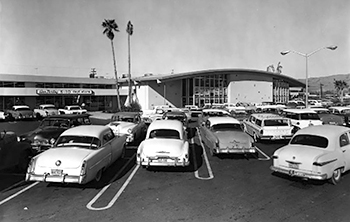
American consumerism and car culture in the 1950s trans-formed the nation’s transportation network.
(Image by Arnold Del Carlo, courtesy of Sourisseau Academy for State and Local History, San José State University.)
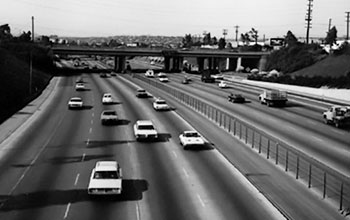
Major cities, such as San Diego, met growing user demand by constructing eight-lane freeways.
(Image courtesy of the Inglewood Public Library Historic Photograph Collection)
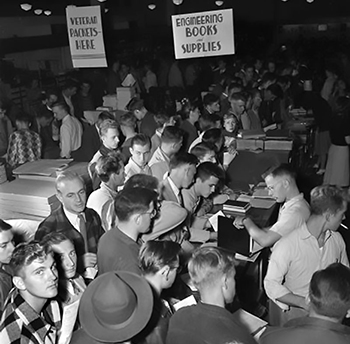
Returning World War II veterans took advantage of the GI Bill and honed their engineering skills at universities nationwide.
(Image courtesy of the Wisconsin Historical Society, photo by the Milwaukee Journal Sentinel, WHI-48544.)
Soldiers arrived home from the war with skills that could immediately be applied to the task of designing and building roads and bridges. Military-trained field engineers were familiar with new construction materials and techniques, having devised innovative ways to quickly and efficiently build structures required by the war effort. Material shortages ended as steel and concrete that had been diverted to the war effort could now be applied to domestic construction. Industries engaged in supporting the military had developed methods for “system” building and prefabrication that could be adapted for the construction of bridges. Shipbuilders and aircraft manufacturers had made significant advances in welding and other fabrication technologies that could be directly applied to bridge construction. Additionally, the GI bill promised to provide the nation with a new cadre of well-trained civil engineers eager to use their knowledge to resurrect the nation’s long-dormant road-building efforts.
Automobile ownership increased exponentially following World War II as America became a country of people obsessed with their cars. Auto makers responded to the increased demand, and by 1948 manufactured nearly four million new vehicles per year. Improvements to existing roads and bridges and new road corridors were necessary to keep pace with traffic during this period. Major cities and State Departments of Transportation were busy planning and constructing expressways and other roads, but could not meet user demand. In 1949 the Federal Bureau of Public Roads noted "the mileage of new roads would not even provide parking space for the cars sold that year."
The post-World War II (postwar) era also witnessed the rapid expansion of suburbia. Increased prosperity and automobile ownership, along with the quest for the American dream of home ownership, led families to move away from crowded city centers. This resulted in large areas of new residential development outside urban centers across the country. New roads, including bridges, transported suburban families to work and shopping areas, which were no longer within walking distance.
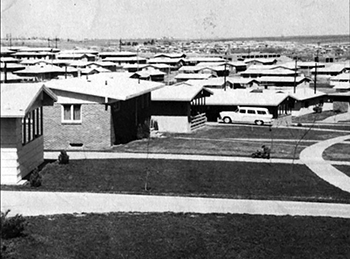
Large areas of new residential housing developed outside urban centers in the postwar era.
(Image from the 1957 Strauss Brothers, “Eastridge, A Great Place to Live” promotional booklet for subdivision in Lincoln, Nebraska.)
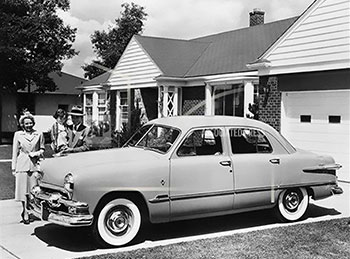
Increased prosperity and the quest for the American dream of home ownership led families to move to newly developed suburbs.
(Image courtesy of Bettmann/Corbis / AP Image 5011100228.)
Hand-in-hand with suburban expansion came the Interstate Highway system. The Federal-Aid Highway Act of 1956 authorized the expenditure of $25 billion dollars over a 12-year period for construction of a “National System of Interstate and Defense Highways.”
President Eisenhower was a driving force behind the Interstate Highway. During the war he witnessed Germany’s autobahn system firsthand and became convinced of the need to improve U.S. roads. The Interstate meant travel without bounds. The driver had no intersections, stop signs, or signal lights and could travel without interruption through and around urban centers and from one State into the next. This national system included 41,000 miles of new roads, built to “the highest standards” of safety and efficiency. To create a seamless network, thousands of similar bridges were needed to span waterways, railroads, and roads, and serve as entrance and exit ramps. By 2006, fifty years after the Interstate system was established, it included more than 47,000 bridges. Most of these structures were nearly identical, as they were built following standard plans. This standardization led to simplified designs, increased construction speed, and economy of scale.
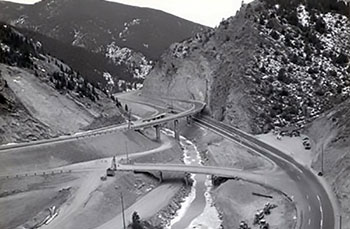
Uninterrupted travel through the Rocky Mountains on Colorado’s Interstate 70.
(Image courtesy of FHWA.)
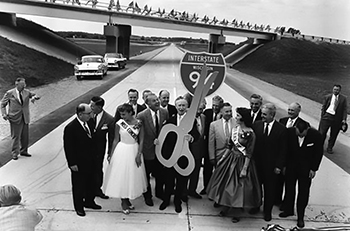
Wisconsin dignitaries celebrate completion of Interstate 94 in 1958.
(Image courtesy of the Wisconsin Historical Society, photo by the Milwaukee Journal Sentinel, WHI-1873.)

